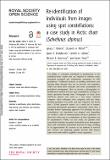Files in this item
Re-identification of individuals from images using spot constellations : a case study in Arctic charr (Salvelinus alpinus)
Item metadata
| dc.contributor.author | Debicki, Ignacy T. | |
| dc.contributor.author | Mittell, Elizabeth A. | |
| dc.contributor.author | Kristjánsson, Bjarni K. | |
| dc.contributor.author | Leblanc, Camille A. | |
| dc.contributor.author | Morrissey, Michael B. | |
| dc.contributor.author | Terzić, Kasim | |
| dc.date.accessioned | 2021-07-28T08:30:15Z | |
| dc.date.available | 2021-07-28T08:30:15Z | |
| dc.date.issued | 2021-07 | |
| dc.identifier | 275214389 | |
| dc.identifier | 11d97fd3-9793-423f-b28a-95adc0692b7d | |
| dc.identifier | 000676322600001 | |
| dc.identifier | 85113211409 | |
| dc.identifier.citation | Debicki , I T , Mittell , E A , Kristjánsson , B K , Leblanc , C A , Morrissey , M B & Terzić , K 2021 , ' Re-identification of individuals from images using spot constellations : a case study in Arctic charr ( Salvelinus alpinus ) ' , Royal Society Open Science , vol. 8 , no. 7 , 201768 . https://doi.org/10.1098/rsos.201768 | en |
| dc.identifier.issn | 2054-5703 | |
| dc.identifier.other | Bibtex: doi:10.1098/rsos.201768 | |
| dc.identifier.uri | https://hdl.handle.net/10023/23658 | |
| dc.description | The long-term monitoring of Arctic charr in lava caves is funded by the Icelandic Research Fund, RANNÍS (research grant nos. 120227 and 162893). E.A.M. was supported by the Icelandic Research Fund, RANNÍS (grant no. 162893) and NERC research grant awarded to M.B.M. (grant no. NE/R011109/1). M.B.M. was supported by a University Research Fellowship from the Royal Society (London). C.A.L. and B.K.K. were supported by Hólar University, Iceland. The Titan Xp GPU used for this research was donated to K.T. by the NVIDIA Corporation. | en |
| dc.description.abstract | The ability to re-identify individuals is fundamental to the individual-based studies that are required to estimate many important ecological and evolutionary parameters in wild populations. Traditional methods of marking individuals and tracking them through time can be invasive and imperfect, which can affect these estimates and create uncertainties for population management. Here we present a photographic re-identification method that uses spot constellations in images to match specimens through time. Photographs of Arctic charr (Salvelinus alpinus) were used as a case study. Classical computer vision techniques were compared with new deep-learning techniques for masks and spot extraction. We found that a U-Net approach trained on a small set of human-annotated photographs performed substantially better than a baseline feature engineering approach. For matching the spot constellations, two algorithms were adapted, and, depending on whether a fully or semi-automated set-up is preferred, we show how either one or a combination of these algorithms can be implemented. Within our case study, our pipeline both successfully identified unmarked individuals from photographs alone and re-identified individuals that had lost tags, resulting in an approximately 4 our multi-step pipeline involves little human supervision and could be applied to many organisms. | |
| dc.format.extent | 19 | |
| dc.format.extent | 2333806 | |
| dc.language.iso | eng | |
| dc.relation.ispartof | Royal Society Open Science | en |
| dc.subject | Capture-mark-recapture | en |
| dc.subject | Spot matching | en |
| dc.subject | Spot extraction | en |
| dc.subject | Deep-learning | en |
| dc.subject | Individual re-identification | en |
| dc.subject | Photo identification | en |
| dc.subject | QA76 Computer software | en |
| dc.subject | QH301 Biology | en |
| dc.subject | QL Zoology | en |
| dc.subject | DAS | en |
| dc.subject.lcc | QA76 | en |
| dc.subject.lcc | QH301 | en |
| dc.subject.lcc | QL | en |
| dc.title | Re-identification of individuals from images using spot constellations : a case study in Arctic charr (Salvelinus alpinus) | en |
| dc.type | Journal article | en |
| dc.contributor.sponsor | NERC | en |
| dc.contributor.sponsor | The Royal Society | en |
| dc.contributor.institution | University of St Andrews. School of Biology | en |
| dc.contributor.institution | University of St Andrews. Centre for Biological Diversity | en |
| dc.contributor.institution | University of St Andrews. School of Computer Science | en |
| dc.contributor.institution | University of St Andrews. Coastal Resources Management Group | en |
| dc.contributor.institution | University of St Andrews. St Andrews Bioinformatics Unit | en |
| dc.identifier.doi | https://doi.org/10.1098/rsos.201768 | |
| dc.description.status | Peer reviewed | en |
| dc.identifier.grantnumber | NE/R011109/1 | en |
| dc.identifier.grantnumber | UF130398 | en |
This item appears in the following Collection(s)
Items in the St Andrews Research Repository are protected by copyright, with all rights reserved, unless otherwise indicated.

